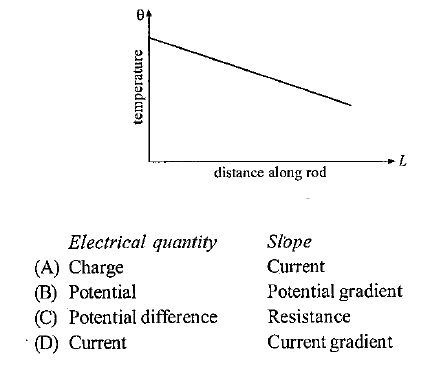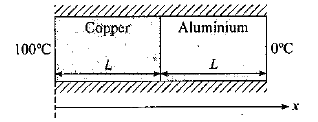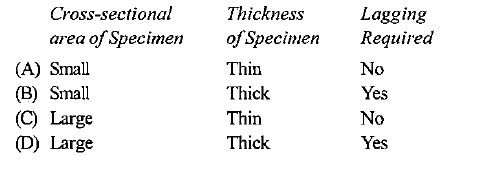Conceptual MCQs Single Option Correct from GK PUBLICATIONS PHYSICS (HINGLISH) HEAT TRANSFER for Class 12
| Class 12 | PHYSICS |
| Chapter | HEAT TRANSFER |
| GK PUBLICATIONS PHYSICS (HINGLISH) | Conceptual MCQs Single Option Correct |
| Medium | English |
| Academic Year | 2023-2024 |
Question 16
The diagram below shows rods of the same size of two different materials P and Q placed end to end in thermal contact and heavily lagged at their sides. The outer ends of P and Q are kept at 0∘C and 100∘C,respectively.The thermal conductivity of P is four times that of Q. What is the steady-state temperature of the interface?
 View Solution
View SolutionQuestion 17
The length of the two rods made up of the same metal and having the same area of cross-section are 0.6 m and 0.8 m respectively. The temperature between the ends of first rod is 90∘ C and 60∘ C and that for the other rod is 150 and 110∘ C. For which rod the rate of conduction will be greaterView SolutionQuestion 21
The graph shows how temperature varies with distance along a well-insulated metal rod which is conducting thermal energy at a steady rate. The slope of this graph is the temperature gradient. There is an analogy between electrical conduction and thermal energy conduction. If an equivalent electrical-graph were to be drawn, which electrical quantity,when plotted against distance along the rod, would have the slope shown. ?
 View Solution
View SolutionQuestion 22
A composite rod of uniform cross-section has copper and aluminium sections of the same length in good thermal contact. The ends of the rod, which is well-lagged, are maintained at 100∘C and at0∘C as shown in the diagram (Figure-4.33). The thermal conductivityof copper is twice that of aluminium.
Which one of the following graphs represents the variation of temperature T with x along the rod in the steady state ?
 View Solution
View SolutionQuestion 23
PQ is a fully-lagged metal bar, containing a section XY of a material of lower thermal conductivity. The thermal conductivities of the two materials are independent of temperature. Ends P and Q are maintained at different temperature.
In the steady , the temperature difference across XY would be independent of :
 View Solution
View SolutionQuestion 24
Two adiabatic vessels, each containing the same mass m of water but at different temperatures, are connected by a rod of length L, cross-section A, and thermal conductivity K. the ends of the rod are inserted into the vessels, while the rest of the rod is insulated so that .there is negligible loss of heat into the atmosphere. The specific heat capacity of water is s, while that of the rod is negligible. The temperature difference between the two vessels reduces to l/e of its original value after a time, δt. The thermal conductivity (K) of the rod may be expressed by:View Solution
All Exercises from GK PUBLICATIONS PHYSICS (HINGLISH) Class 12 PHYSICS HEAT TRANSFER
- PRACTICE EXERCISE 4.1
- PRACTICE EXERCISE 4.2
- PRACTICE EXERCISE 4.3
- PRACTICE EXERCISE 4.4
- DISCUSSION QUESTION
- CONCEPTUAL MCQS SINGLE OPTION CORRECT
- NUMERICAL MCQS SINGLE OPTIONS CORRECT
- ADVANCE MCQS WITH ONE OR MORE OPTION CORRECT
- UNSOLVED NUMERICAL PROBLEMS FOR PREPARATION OF NSEP,INPHO&IPHO
- ILLUSTRATIVE EXAMPLE 4.1
- ILLUSTRATIVE EXAMPLE 4.10
- ILLUSTRATIVE EXAMPLE 4.11
- ILLUSTRATIVE EXAMPLE 4.12
- ILLUSTRATIVE EXAMPLE 4.13
- ILLUSTRATIVE EXAMPLE 4.14
- ILLUSTRATIVE EXAMPLE 4.15
- ILLUSTRATIVE EXAMPLE 4.16
- ILLUSTRATIVE EXAMPLE 4.17
- ILLUSTRATIVE EXAMPLE 4.18
- ILLUSTRATIVE EXAMPLE 4.19
- ILLUSTRATIVE EXAMPLE 4.2
- ILLUSTRATIVE EXAMPLE 4.20
- ILLUSTRATIVE EXAMPLE 4.21
- ILLUSTRATIVE EXAMPLE 4.22
- ILLUSTRATIVE EXAMPLE 4.23
- ILLUSTRATIVE EXAMPLE 4.24
- ILLUSTRATIVE EXAMPLE 4.25
- ILLUSTRATIVE EXAMPLE 4.26
- ILLUSTRATIVE EXAMPLE 4.27
- ILLUSTRATIVE EXAMPLE 4.28
- ILLUSTRATIVE EXAMPLE 4.29
- ILLUSTRATIVE EXAMPLE 4.3
- ILLUSTRATIVE EXAMPLE 4.4
- ILLUSTRATIVE EXAMPLE 4.5
- ILLUSTRATIVE EXAMPLE 4.6
- ILLUSTRATIVE EXAMPLE 4.7
- ILLUSTRATIVE EXAMPLE 4.8
- ILLUSTRATIVE EXAMPLE 4.9

